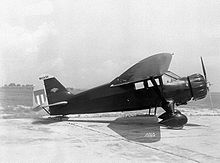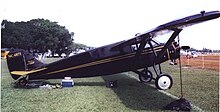 | |
| Industry | Aerospace |
|---|---|
| Founded | 1920; 105 years ago (1920) |
| Founders | Eddie Stinson |
| Defunct | 1948 (1948) |
| Fate | Defunct |
| Headquarters | Detroit, Michigan, U.S. |
| Key people | William A. Mara |
| Parent |
|




The Stinson Aircraft Company was an aircraft manufacturing company in the United States between the 1920s and the 1950s.
History
The Stinson Aircraft Company was founded in Dayton, Ohio, in 1920 by aviator Edward “Eddie” Stinson, the brother of aviator Katherine Stinson. After five years of business ventures, Eddie made Detroit, Michigan the focus of his future flying endeavors while still flying as a stunt pilot, earning $100,000 a year for his efforts — a huge sum in those days.
Stinson found Detroit's business community receptive to his plans to develop his own airplane. Alfred V. Verville and a group of local businessmen — the Detroit Board of Commerce's Aviation Committee — supported Stinson's plans to establish the Stinson Aircraft Syndicate in 1925, and provided $25,000 to design and build a prototype, an enclosed cockpit, 4-place biplane, powered by a Wright Whirlwind J-4 air-cooled radial engine test flighted at Packard Field in Roseville, Michigan, a northeast suburb of Detroit. Packard Field was the first commercial air field in Michigan, opened in 1919, site of Packard Aviation and the Michigan State School of Aviation, making it a natural location for Stinson to launch his business in the Detroit area.
The Stinson Detroiter SB-1 (for "Stinson Biplane model 1") made its maiden flight from Packard Field on January 25, 1926. The plane not only had a rare (for the period) enclosed cabin, it also had heat (which was a big plus given the cold Michigan winter), upholstered seats and side panels, and even an electric cigar lighter. It became an overnight success, and flights were offered in February to 70 riders thus enabling Stinson to raise $150,000 in public stock capital to go into production. Stinson incorporated in Michigan as the Stinson Aircraft Corporation. On May 4, 1926, Eddie acquired the Stimson (no connection to Stinson and no typo error) Scale Mfg. building in Northville, Michigan, just across the pond from the locally famous Ford Valve Plant, and the first production model SB-1 rolled out just three months later in August 1926. Stinson employed over 250 workers at the Northville factory in 1926.)
The aircraft were too large to be completely assembled in the Northville plant, so the wings were attached to the fuselage just west of town at the new, local Northville Airfield, a land project owned by a group of village entrepreneurs established to support the Stinson factory. Aircraft were then flown and delivered from here to buyers. Stinson Aircraft Corp. sold a remarkable 18 SB-1 Detroiters by the end of 1926, completing manufacture of 10 aircraft, while the prototype SB-1 was sold to Horace Dodge, son of one of the Dodge Motor Cars founders.
Northwest (today Delta Airlines) sold its first passenger ticket in July 1927, on their first of several SB-1s (and later SM-1s). By this time, the Stinson Corp. had erected their own concrete-floored steel hangar at the airfield, where they could complete the aircraft assembly process of attaching the wings. The finished superstructure fuselages were simply pulled through the center of town to the airfield behind Ford Model TT trucks, while the wings were put on trailers.
Toward the end of 1926, Stinson Aircraft Corp. began developing their next generation SM-1 (Stinson Monoplane type 1), a six-place monoplane initially powered by the more powerful Wright J-5. The maiden flight took place in the spring of 1927. Coincidentally, the new monoplane had nearly the same wing dimensions and many similar design elements of the Ryan monoplane flown in Lindbergh's famous transatlantic flight of May 1927. This model eventually replaced the biplane completely, and by 1928 the SB-1 was out of production by the time the FAA finally got around to officially certificating it. The early SM-1s were built and flown out of Northville, but the company outgrew its facilities and left Northville by 1929, moving to Wayne, Michigan, which was next to the site of the Detroit Industrial Airport.
Business was steadily increasing, and Stinson delivered 121 aircraft in 1929.
Automobile mogul Errett Lobban (E.L.) Cord acquired 60 percent of Stinson's stock in September 1929, and his Cord Corporation provided additional investment capital to permit Stinson to sell its aircraft at a competitive price while still pursuing new designs. At the height of the Depression in 1930, Stinson offered six aircraft models, ranging from the four-seat Junior to the Stinson 6000 trimotor airliner.
Eddie Stinson did not live to enjoy the success of his company. He died in an air crash in Chicago, Illinois on January 26, 1932, while on a sales trip. At the time of his death at age 38, Stinson had acquired more than 16,000 hours of flight time — more than any other pilot at the time.
The Stinson name did not last for long past the end of World War II. Eddie Stinson's death accelerated the assimilation of Stinson Aircraft Corporation into larger corporate entities: first by Cord Corporation, then by Aviation Corporation (AVCO), and later by Consolidated Vultee. In 1948, the Stinson company was sold to the Piper Aircraft Corporation, which continued to produce 108s for a limited time. Piper transformed an original Stinson design (the "Twin Stinson") into the successful Piper Apache, the world's first general aviation all-metal twin-engined modern aircraft.
Aircraft

| Model name | First flight | Number built | Type |
|---|---|---|---|
| Stinson SB-1 Detroiter | 1926 | 26 | Single engine cabin biplane |
| Stinson SM-1 | 1927 | 71+ | Single engine cabin monoplane |
| Stinson SM-2 | 1928 | ~27 | Single engine cabin monoplane |
| Stinson SM-3 | 1 | Single engine cabin monoplane | |
| Stinson SM-4 | 1 | Single engine cabin monoplane | |
| Stinson SM-5 | 1 | Single engine cabin monoplane | |
| Stinson SM-6 | 12 | Single engine cabin monoplane | |
| Stinson SM-7 | 16 | Single engine cabin monoplane | |
| Stinson SM-8 | ~300 | Single engine cabin monoplane | |
| Stinson SM-9 | 1 | Twin engine monoplane flying boat | |
| Stinson SM-6000 Airliner | 53 + 24 | Trimotor monoplane airliner | |
| Stinson Model W | 5 | Single engine cabin monoplane | |
| Stinson Model R | 1931 | 39 | Single engine cabin monoplane |
| Stinson Model O | 1933 | 9 | Single engine open cockpit monoplane |
| Stinson SR | 1933 | 1,327 | Single engine cabin monoplane |
| Stinson Model A | 1934 | 31 | Trimotor monoplane airliner |
| Stinson 105 | 1939 | 1,052 | Single engine cabin monoplane |
| Stinson Model 74 | 1940 | 324 | Single engine liaison monoplane |
| Stinson V-76 Sentinel | 1941 | 3,896+ | Single engine liaison monoplane |
| Stinson 108 | 1944 | 5,260 | Single engine cabin monoplane |
| Stinson L-13 | 1945 | 2 | Single engine liaison monoplane |
References
Footnotes
- Only two aircraft were built by Vultee-Stinson, the remaining 300 were built by Convair after Stinson was sold.
Notes
- "Northville: Economics & Education – Michigan History".
- Images of Aviation, The Stinson Aircraft Company
- The Stinson Aircraft Company by Bluth, Arcadia Publishing
- Northville by Fecht, Arcadia Publishing
- "SB1 – International Stinson Club".
- "Where Was Michigan's First Commercial Airport?". 99.1 WFMK.
- Flying Magazine: 78. August 1945.
{{cite journal}}: Missing or empty|title=(help) - "Stinson Aircraft Co. Sold to Piper Co". Intelligencer Journal. AP. p. 14. Retrieved 11 March 2020.
Bibliography
- "Stinson Aircraft Corporation" by Roger Guillemette, US Centennial of Flight Commission, retrieved January 6, 2006
External links
- Stinson "S" Junior Specifications and Photos
- Short story and pictures of the Packard Diesel-powered Stinson SM-1
| Stinson aircraft | |||||||||||||||||||
|---|---|---|---|---|---|---|---|---|---|---|---|---|---|---|---|---|---|---|---|
| Model numbers |
| ||||||||||||||||||
| Names | |||||||||||||||||||
| Military designations |
| ||||||||||||||||||